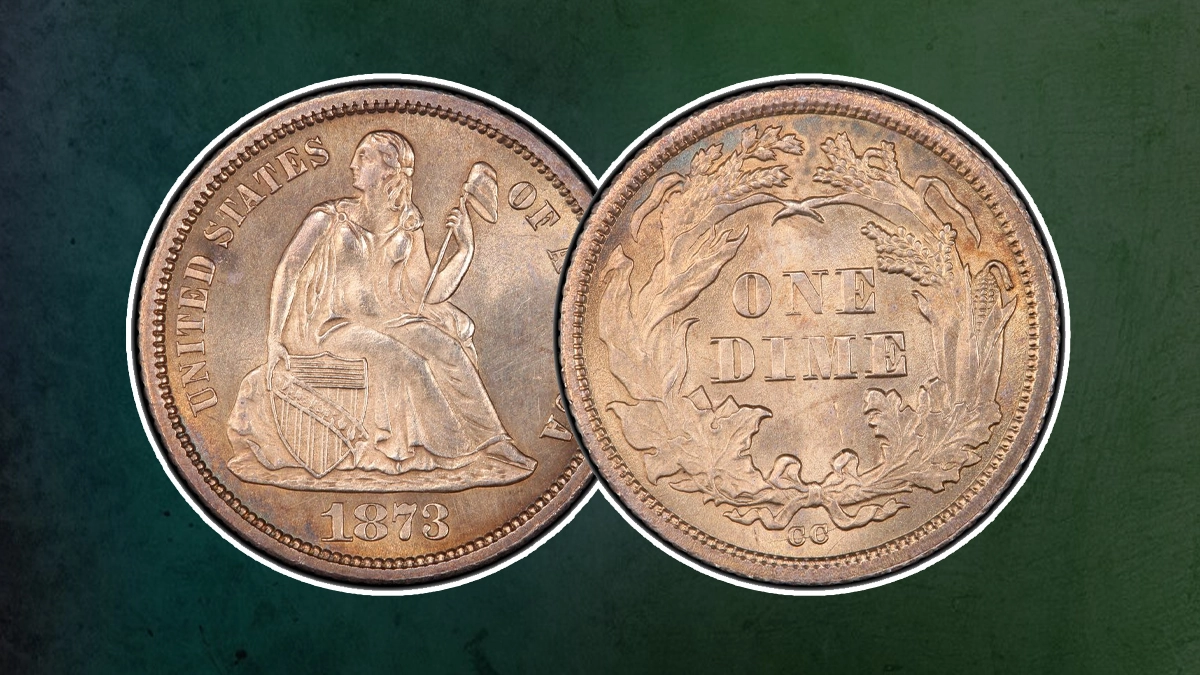
The 1873-CC Liberty Seated Dime, known for its historical significance and scarcity, is coveted by coin collectors. These coins date from 1837 to 1891 and are from the Liberty Seated series, struck at the Carson City Mint. The 1873-CC dimes come in two varieties: with arrows and without arrows. The arrows at the date were used to indicate a difference in the weight of the coins, a practice that started in 1873.
History of 1873-CC Liberty Seated Dime
The Carson City Mint, located in Nevada, was established in 1863 to serve the requirements of the booming silver mining industry in the area. Coins produced at this mint are determined by the “CC” mintmark. The 1873-CC dimes were struck during a time of important change in U.S. coinage, as the Coinage Act of 1873 presented new standards and guided the discontinuation of the two-cent piece, the silver half dime, and the silver dollar. The introduction of arrows on coins in 1873 revealed a slight increase in the weight of the dimes from 2.49 grams to 2.50 grams.
Specifications
- Designer: James Barton Longacre
- Edge: Reeded
- Diameter: 17.90 millimeters
- Weight: 2.50 grams
- Composition: 90% Silver, 10% Copper
- Mint: Carson City
- Mintage: 18,791
- Auction Record: $552,000 (MS65, August 28, 2022, Heritage Auctions)
Basic Design
Obverse: The obverse of the 1873-CC Liberty Seated Dime features the figure of Liberty seated on a rock, holding a shield in her right hand and a pole topped with a Liberty cap in her left hand. The word “LIBERTY” is inscribed on a ribbon across the shield. The date “1873” appears at the bottom of the coin, with the “CC” mintmark below the wreath.
Reverse: The reverse design shows a wreath of laurel tied with a ribbon, covering the denomination “ONE DIME.” The wreath design differs slightly between different years and mint locations.
Varieties: With Arrows and No Arrows
- With Arrows: The 1873-CC dimes with arrows feature small arrows on either side of the date. These arrows were added to indicate the change in the coin’s weight demanded by the Coinage Act of 1873.
- No Arrows: The 1873-CC dimes without arrows were minted before the weight change was executed, making them slightly rarer than their counterparts with arrows.
Rarity and Condition
Specifically in very good condition, the 1873-CC Liberty Seated Dime has been considered to be one of the rare coins in the Liberty Seated series. The 18,791 coin mintage is an ingredient that contributes to its rarity. Collectors particularly value coins in mint state (MS) condition, with the best grades getting important premiums. This coin has the highest auction record of $552,000 for an MS65 grade, indicating its outstanding worth and popularity.
Value of 1873-CC Liberty Seated Dime
The value of an 1873-CC Liberty Seated Dime varies extremely based on its condition and specific variety (with or without arrows). Coins in lower grades (Good to Fine) can range from several hundred to a few thousand dollars. The highest auction record for this coin is $552,000 for a coin graded MS65, underscoring its value and desirability.
Errors and Varieties
Like many coins from the 19th century, the 1873-CC Liberty Seated Dime can show various mint errors and die varieties, which also increases its interest to collectors. Common errors have die cracks, repunched dates, and variations in the positioning of the mintmark. Collectors strive out these unique features as they add another layer of collaboration and reputation to the coin.
Also Read – 1796 Draped Bust Dime: A Complete Guide
Conclusion
The 1873-CC Liberty Seated Dime, a famous coin represents the rich history of the Carson City Mint and the more complete knowledge of American coinage throughout the 19th century in numismatic history. It is valued by collectors because of its rarity, unique design, and historical value. Whether it has arrows or not, the design of this coin represents a real connection to the past and the artistry and history of American coinage.
